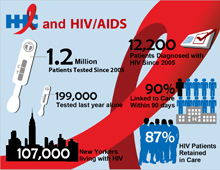| NYC Resources | 311 | Office of the Mayor |
|
|
Important notice on data breaches affecting some HHC patients |
Growing Up With HIV
During high school graduation season in June, it’s not unusual for Dr. Andrew Wiznia’s cell phone to vibrate frequently while he's in clinic with patients. As Director of Family HIV Services for Jacobi and North Central Bronx Hospitals, Dr. Wiznia gets a steady flow of photos from his patients’ proud parents who want to share the moment when their HIV positive teenager walks across the stage to receive a diploma. “The family’s jubilation is understandable,” said Dr. Wiznia. “After all, it was not so long ago that babies born with HIV were only expected to live to be about 10.” The advancement of HIV antiretroviral drugs has helped people with HIV to stay healthy and live longer. And that includes HIV’s youngest patients who are under 25 years old and make up almost 8 percent of the 20,000 individuals with HIV who receive care at HHC hospitals and health centers. Dr. Ninad Desai, Chief of Pediatrics and Director of Pediatric HIV Services at Kings County Hospital Center, has been treating children with HIV/AIDS for 18 years and vividly recalls a case that represents all the progress that has been made in caring for young people with HIV. “About 15 years ago, I had the adoptive father of one of my patients sitting in front of me. He had picked out the funeral dress and the coffin for the child because she was at death’s door.” Dr. Desai decided to try one more drug on the child. “That young lady is alive today and has a child of her own who is uninfected,” he said proudly. Providing HIV-infected women with prenatal care and HIV treatment has significantly reduced the number of babies born HIV-infected; in New York City, the number has gone from a high of 258 infants born HIV-infected in 1990 to 1 in 2010, according to the most recent New York City Health Department data. HHC’s pediatric and adolescent HIV/AIDS programs provide HIV specific care, primary care, psychosocial care and case management, with the family included as part of the caregiving and support network. Some programs include specialists such as nutritionists and all coordinate referrals to subspecialists, if needed. While the treatments are saving lives, Dr. Desai points out that as adolescents, the children face the same physical stigma of the ravages of the disease and treatment that many adults encounter. Children are treated with the same groundbreaking HIV antiretroviral drugs available to adults but made in pediatric formulations, in liquid form instead of pills, or compounded so that they can be dissolved in juice. “Many young patients face a wide spectrum of medical and mental health challenges as a result of years of invasive treatments, medicines that cause side effects, the death of parents from AIDS, or finally comprehending that they are HIV positive,” said Dr. Desai. Some other common medical conditions and mental health implications among children and adolescents with HIV can include:
“And they are experiencing their sexual awakening,” Dr. Desai said. HHC pediatric care providers who specialize in the treatment of HIV positive teens include safe sex talks as part of their sessions and share tips on how to tell their partner about their diagnosis, and use condoms and other methods to protect themselves and their partner. Dr. Desai said that the clinics also make other providers available to talk to the teens, including social workers or specialists of the same sex, which may make the young patients feel more at ease. “We want them to talk freely. We create a circle of safety for them.” As the kids move into their late teens, the doctors begin to work with them to make the transition to a health care provider for adults. Sometimes it takes a year, sometimes it takes much longer, the doctors said. It’s crucial that the patient not fall out of care during this process. Not surprisingly, the HHC doctors who follow these children since birth develop a very close and special bond. They consider themselves more than provider and patient and become like family. When teenagers with HIV head off to college, the doctors arrange for them to continue to get their medications and help them find a pharmacist who will provide the drugs without labels to provide privacy from roommates. The doctors even help the teenagers seek financial aid and scholarships. “When one of my patients, a child born with HIV, makes it to college having survived so much, I feel an overwhelming desire to help them in any way I can, encourage their education and support them through their life goals,” Dr. Desai said.
| ||||
HHC 2014 Stats
- Staffed Beds: 6,684
- Clinic Visits: 4,472,960
- ER Visits: 1,179,436
- Discharges: 205,791
- Births: 18,564
| Copyright 2015 The City of New York | Contact Us | Privacy Policy | Terms of Use |


